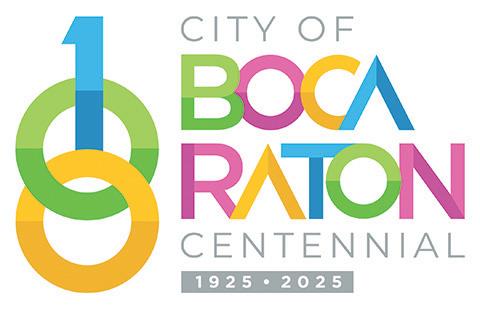






The City of Boca Raton is moving forward with a transformative long-term vision for its Government Campus through a partnership with Boca Raton City Center, LLC, a joint venture between the Miami-based Terra and Palm Beach-based Frisbie Group (Terra & Frisbie Group).
This initiative, which has been years in the making, builds on strategic planning efforts to redevelop the campus into a vibrant civic and community hub. The Boca Raton City Council made the unanimous decision during its February 11th meeting, marking a significant milestone in the process to modernize and revitalize the campus, ensuring that public facilities evolve to meet the needs of the community and enhance the efficiency of city services.
“Boca Raton’s future is brighter than ever,” said Mayor Scott Singer. “This project is more than just a redevelopment; it’s about creating a civic center that better serves our community, provides opportunities for employment and business and transforms the town square into a destination where residents want to be.”
The selection of Terra & Frisbie Group for this public-private partnership (P3) follows an extensive competitive process aimed at identifying the most qualified team to revitalize the Government Campus. The downtown Boca Raton area currently houses City Hall, the police station, a community center, a tennis center and more.
In addition to updating government facilities, the mixed-use proposal features enhanced green spaces, community-focused amenities, residential units, a hotel, office and retail space, all designed to enhance the downtown experience. The initiative also aims to capitalize on the proximity to the Brightline Station, providing for improved connectivity and mobility in the city, and for those traveling to and from Boca Raton.
“We are honored to have been unanimously chosen by the Boca Raton City Council to lead the Government Campus Redevelopment,” said Terra CEO David Martin. “Our team is committed to transforming this space into a vibrant, eco-friendly district that blends civic, residential and commercial uses. We look forward to collaborating closely with city officials and the community to bring our shared vision to life, creating a sustainable and connected neighborhood that will serve as a model for future urban development.”

Already considered one of our nation's most beautiful cities, this architectural rendering of downtown Boca Raton's Government Center shows what the complex will look like when completed—with City Hall at the upper right—and promises an even grander future.
“Boca Raton is an exceptional community that deserves the best,” said Cody Crowell of Frisbie Group. Rob Frisbie, Jr. continued, “We’re committed to listening to residents, businesses and city leaders to ensure we create an exciting project that will enhance the quality of life for all.”
Building on input already gathered from the community, public engagement will continue to be a key component of this initiative, with multiple ways to continue to participate, including
Mark your calendars. Here is an event you will want to look forward to this summer and fall!
As Boca Raton marks its 100th anniversary the Schmidt Boca Raton History Museum will be presenting “1925!”, a new exhibit that transports visitors back to the year of the city’s incorporation. Running from July 2nd to December 20th, the exhibit will



immerse guests in the culture, style and innovations that defined this transformative era in both Florida and American history.
“The year 1925 was pivotal for Boca Raton, setting the stage for the city’s remarkable growth over the last century,” said Mary Csar, Executive Director of the Boca Raton Historical Society. “This exhibit offers a fascinating glimpse into what life was like at the time, showcasing how history, fashion and innovation converged to shape our community.”
From rising hemlines and rebellious flappers to the Florida land boom that first put Boca Raton on the map, “1925!” explores the everyday lives and pop culture trends that shaped the Roaring Twenties. Through a carefully curated collection of historic images and artifacts, visitors will discover:































Path to College Fellowship—a non-profit organization dedicated to helping low-income, driven Palm Beach County high school students realize their college dreams— hosted its annual Shine & Dine gala for more than 300 guests on January 25th at the Kravis Center in West Palm Beach.
Founded in 2017, Path to College empowers local students with the support, guidance and resources necessary to pursue higher education at top-tier universities while graduating with little to no debt. To date the organization has achieved enabled more than 120 students to attend four-year universities, with over 60% securing full-ride scholarships.
At the event Hayley J. Little, Executive Director of the Glenn W. and Cornelia T. Bailey Foundation, announced a $1 million endowment that will fund operations at Path to
Boca History Museum to Debut “1925!” from page 1
• The bold fashions of the era, from beaded dresses to boater hats;
• Elegant interior design trends that ushered in the modern age
• The evolution of automobiles and their impact on daily life;
• The rise of modern conveniences, such as indoor plumbing and electricity;
• The booming popularity of sports, including baseball and golf;

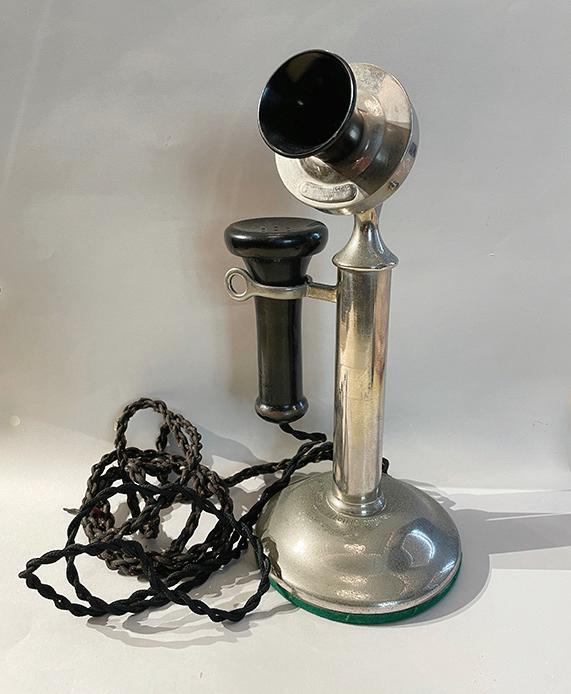
Dr. Rosenbusch has been practicing dentistry for 34 years and has extensive experience in many aspects of dentistry. His main focus is on Cosmetic Dentistry, Laser Dentistry and Implant Prosthetics
College’s Catapult Youth Mentoring Center in perpetuity. Little challenged the gala guests to “make it $2 million.” Set to open later this year, Catapult will be a no-cost, after-school welcoming space for homework help, college preparation, SAT studying and project-based learning within walking distance from Lake Worth Community High School.
“We are grateful for the investment in our future that this extraordinary gift represents,” said Christine Sylvain, Founder and CEO of Path to College “The generosity of this donor will impact our work at the Catapult Center and allow us to ensure every student – no matter their start –knows they are seen, valued and destined for success.”
Hosted by CBS 12 News Anchor Matt Lincoln, Shine
• The Florida real estate frenzy, which sparked both prosperity and bust, and
• The iconic flapper lifestyle that redefined social norms for women.
The “1925!” exhibit will be on display at the Schmidt Boca Raton History Museum, located at Town Hall, 71 N. Federal Highway. For more information call (561) 3956766 or visit www.BocaHistory.org.
About The Schmidt Boca Raton History Museum
The Schmidt Boca Raton History Museum is the home of the Boca Raton Historical Society, whose mission is to collect, preserve and present information and artifacts relevant to the past and evolving history of Boca Raton and to maintain a visible role in the education and the advocacy of historic preservation in the community. Now open to the public Wednesday through Saturday, 10 a.m. to 4 p.m., the museum is in historic Town Hall at 71 N. Federal Highway (33432). For more information, please call (561) 395-6766 or visit www.BocaHistory.org.

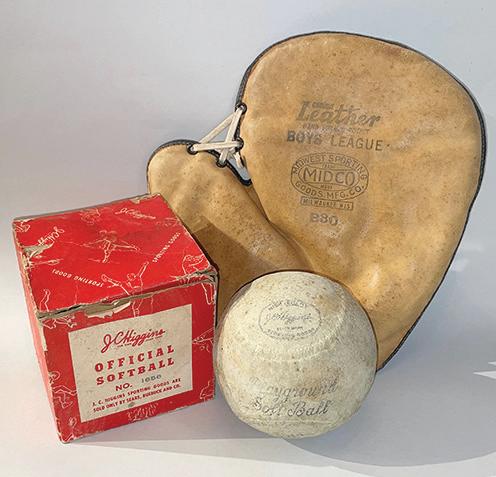

bocadentist12@gmail.com
& Dine was an evening of exquisite dining, dancing, entertainment and a live auction showcasing luxury gifts. Each Shine & Dine table included a Path to College alumnus or current student. The evening’s toast was led by Daniel Tovar, a senior at John I. Leonard High School in West Palm Beach, who was recently awarded a Questbridge Scholarship match and the South Florida Fair scholarship, securing a full ride to Brown University.
Path to College provides students with a threeyear fellowship that includes SAT college entrance test preparation, business and social skills-building, mental wellness and mindfulness training, mentoring and internships, career exposure and exploration, scholarship assistance and financial literacy.
“We’re providing these driven, yet overlooked students with the long-term support, compassionate guidance and academic rigor they need to be competitive,” Sylvain said. “We show them just how far their intellectual engines can take them.”
About Path to College. Path to College Fellowship is a local 501(c)(3) non-profit organization dedicated to clearing the path for overlooked students to gain admission to top colleges with the best scholarships. The organization envisions a world where genius, leadership and excellence are cultivated. Path to College raises the bar for low-income, high-achieving students in Palm Beach County by expanding minds and igniting potential. For more information call (561) 203-5338 or visit www.pathtocollege.org.
City of Boca Raton Partners from page 1
attending Council meetings, submitting comments via the Government Campus Feedback Form, learning more on the city’s website and signing up for project alerts. The community was also invited to attend an upcoming Open House on the proposed plan that took place on February 19th, where they viewed renderings, met Terra Frisbie & Group team members and shared their ideas.
Next steps for the project include the following phases:
• Interim Agreement – City staff will work with Terra & Frisbie Group to execute a short-term agreement by March 18th.
• Comprehensive Agreement – Following the interim agreement, the city and Terra & Frisbie Group will negotiate a full agreement. This process will take time, and there will be significant opportunities for public information and input throughout.
• Project Advancement – Once the comprehensive agreement is finalized the project will move into the next phase, including detailed design, permitting, and construction. The city will continue to provide ongoing updates to ensure transparency and public engagement.
Discussions about revitalizing the Government Campus began in 2017 and have been a key component of the city’s strategic planning to redevelop the area. To support this initiative the city partnered with CBRE, Inc., a firm with extensive experience in managing P3s, who continues to provide guidance throughout the process.
For more information and continued updates visit the Government Campus webpage, and follow the city on social media.







Elliot Weiss and Michael Champagne’s award-winning song cycle,” Bittersuite: Songs of More Experience,” will run for two performances only at the Levis JCC Sandler Center March 22nd and 23rd. The production is part of the JCC’s Robert Greenberg Performing Arts Series.
The production is an extension of the acclaimed revue that ran in New York, San Francisco and for two years in Los Angeles, where it was singled out as a “critic’s choice” by the LA Times, LA Weekly, and Daily News In this edition the cycle continues to explore the American Experience in song, but from a more mature perspective. “Bittersuite” explores growing old in America, what it feels like, and what it means: How do the issues of love, loneliness, success and failure, change and accommodation, impact our lives as we age?


“Michael Champagne and I had just completed a workshop of our first musical, ‘Casanova – A Musical Romance,’ and we were having trouble attracting a producer due to the size of the cast,” Bittersuite composer Elliot Weiss recalls. “We decided to scale down and write a song cycle for four singers and piano. We envisioned it to be performed with no props or sets. To let the material speak for itself. But what should we write about? Seeing as both of us were rapidly approaching middle age it seemed that how people feel when their youthful
expectations collide with their present-day reality could be a fertile field to explore.”
“‘Bittersuite’ grew out of our interest in exploring the realities, both sweet and bitter, of American life,” Michael Champagne continued. “We first presented the show in a seedy little Off-Off Broadway theater in New York, where it caught fire and moved into the cabaret theatre scene in a stylish uptown location. ‘Bittersuite: Songs of Experience’ has had great success, won many awards, and has been performed many times all over the world.”
“Years went by, and lo and behold, Michael and I were now approaching our golden years.” Weiss continued. “It seemed with so much more knowledge, regrets, wisdom, foolhardiness—and everything else that comes with aging— it was time to update ‘Bittersuite’ and call it ‘Bittersuite: Songs of More Experience.’ This latest version of the show, which has been tailored and updated specifically for South Florida audiences, won the New Jersey Broadway World Best Musical award when we first performed it!”
“‘Bittersuite: Songs of More Experience’ is a musical ‘selfie’ taken forty years later,” Champagne concludes. “And reflects some of the deeper perspectives time brings with it.”
“Bittersuite: Songs of More Experience” is being staged by Holly Budney, and Weiss serves as the show’s Musical Director. The production features Francine Birns, Lisa Fishman, David Hyman and Shane Tanner. The four actor/ singers use narrative song, set pieces, humor and pathos to express the currents flowing through the American psyche to produce an unflinching view of who we are and what we hope as we grow older.
“Bittersuite: Songs of More Experience” will be performed at the Levis JCC Sandler Center on Saturday, March 22nd and Sunday, March 23rd. Both performances will take place at 7:30 p.m. Tickets are $35/$40 each and are on sale now. For tickets and information visit https:// levisjcc.org/culture/performingarts/ or call (561) 558-2520.
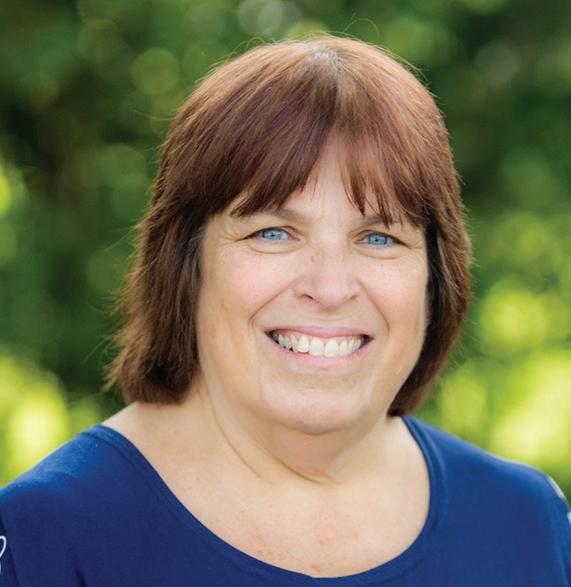
B’nai Torah Congregation, the largest conservative synagogue in Southeast Florida, announced that Dr. Cathy Berkowitz, who has led the synagogue’s Mirochnick Religious School for over two decades, will serve as the next President of the Jewish Educators Assembly (JEA). She will be officially installed during the 73rd Annual JEA Conference, which begins March 16th, in Chicago.
The Jewish Educators Assembly (JEA) is the leading professional association for Conservative/Masorti education professionals. Its membership includes full-time and parttime education directors, early childhood education directors, youth directors, clergy-educators, university and seminary students and supplementary (Hebrew) schoolteachers.
“This honor is a well-deserved recognition of Dr. Berkowitz’s dedication, passion and leadership in Jewish education, said Rabbi David Steinhardt, Senior Rabbi of B’nai Torah Congregation. “Dr. Berkowitz’s success is a reflection of B’nai Torah—a place where education is valued, where tradition and innovation come together, and where lifelong learning thrives.”
A wife, mother of four and proud grandmother of two, Dr. Berkowitz joined B’nai Torah Congregation in 2004 as Education Director of the Religious School. She had served as Education and Program Director at Beth Sholom Synagogue in Memphis, Tennessee, prior to joining B’nai Torah. Dr. Berkowitz is also a founding faculty member of Camp Ramah Darom, has served as Rosh Chinuch for twenty summers and

represented Camp Ramah Darom at national conferences.
“I have spent over 21 years doing my best to make the Mirochnick Religious School the heart of B’nai Torah by shaping meaningful learning experiences for our students and families,” said Dr. Berkowitz. “I am thrilled to accept this incredible honor and look forward to continuing to make an impact on our community and beyond.”
Dr. Berkowitz earned an M.A. in Public Administration and Education from Brooklyn College and pursued studies in Jewish Education at Siegal College. She was awarded an honorary Doctorate in Education Pedagogy from the Jewish Theological Seminary. She is the former chair of the Education Directors Council of South Palm Beach County and most recently served as the executive vice president of the JEA.

For more information about the Mirochnick Religious School and B’nai Torah Congregation, visit https://www. btcboca.org/learning/mirochnick-religious-school/. About B’nai Torah Congregation. B’nai Torah Congregation has over 1,300 membership families. It is a close-knit, multi-generational, modern and egalitarian synagogue that offers diverse services, programs of worship, learning, tzedakah, social action and social activities. B’nai Torah Congregation creates an outlet for arts, culture and learning, a home to several schools of Jewish education. The synagogue, which offers a variety of volunteer opportunities to enrich the synagogue experience, is a center for tzedakah acts and projects that touch thousands of people. Learn more at https://btcboca. org.













I have cash buyers that are currently looking for the following. Call me now if you are thinking of selling in the near future.
Buyer 1. Courtyard style home up to 3.6 million depending on condition
Buyer 2. Single family home up to 2 million. They will renovate if needed.
Buyer 3. Home with 2 bedroom plus a den. 800k-1.5 million. They will renovate.
Buyer 4. Home in Whisper Trace, Laurel Point or Timber Mill with primary suite on the ground floor

Men Giving Back of South Palm Beach County, the Boca Raton-based membership organization that collectively supports a variety of non-profits throughout South Palm Beach County, is now accepting applications for its 2025 Golden Grant Awards program. The deadline to submit applications is April 1st, 2025.
Men Giving Back awards several grants annually in support of organizations based in South Palm Beach County that focus on one of its four core mission objectives: Children, Education, Mental Health and Food Security.
Since the organization’s inception in 2020, Men Giving Back has awarded nearly $2 million in grants to a number of local nonprofits. Last year alone, over half a million dollars was awarded to 25 charities at the organization’s Golden Grants Evening in November.
“Seeing how much Men Giving Back has been able to grow over the past half-decade has been some of the most impactful work of my life,” said Dr. Nathan Nachles. “I can’t wait to see what amazing organizations we’ll get a chance to support this year.”
All eligible charities and organizations are encouraged to apply. For more information or to apply, visit: https:// www.mengivingback.org/eligibility-criteria
At its first meeting of 2025 the Boca Raton Police Foundation elected four officers and welcomed the following five new members to its Board of Trustees: Kevin Day, Director of Security and Life Safety, CP Group which manages BRiC; Bob Keating, Director of Security, GEO Group; Rich Mattessich, Chief Legal Officer, Celsius; Tim Frost, Owner, Frost Security; and Chief Sean Brammer of Florida Atlantic University’s Police Department.
Each joins several other Trustees in fulfilling the Foundation’s mission of supporting the Boca Raton Police Department to help keep citizens safe.
At the same meeting Alan Rose, a Boca Raton resident, was elected Foundation Chair. He agreed to serve until 2026 and then be replaced by Chair Elect Nicole Flier. Serving as Secretary is Jeff Hollander and Craig Ehrnst is Treasurer.
Editor Nils A. Shapiro
Editorial copy appearing herewith is not necessarily the viewpoint of Seabreeze Publications of Central Florida. Most editorial copy is created by the homeowners and is edited by their appointed editor.

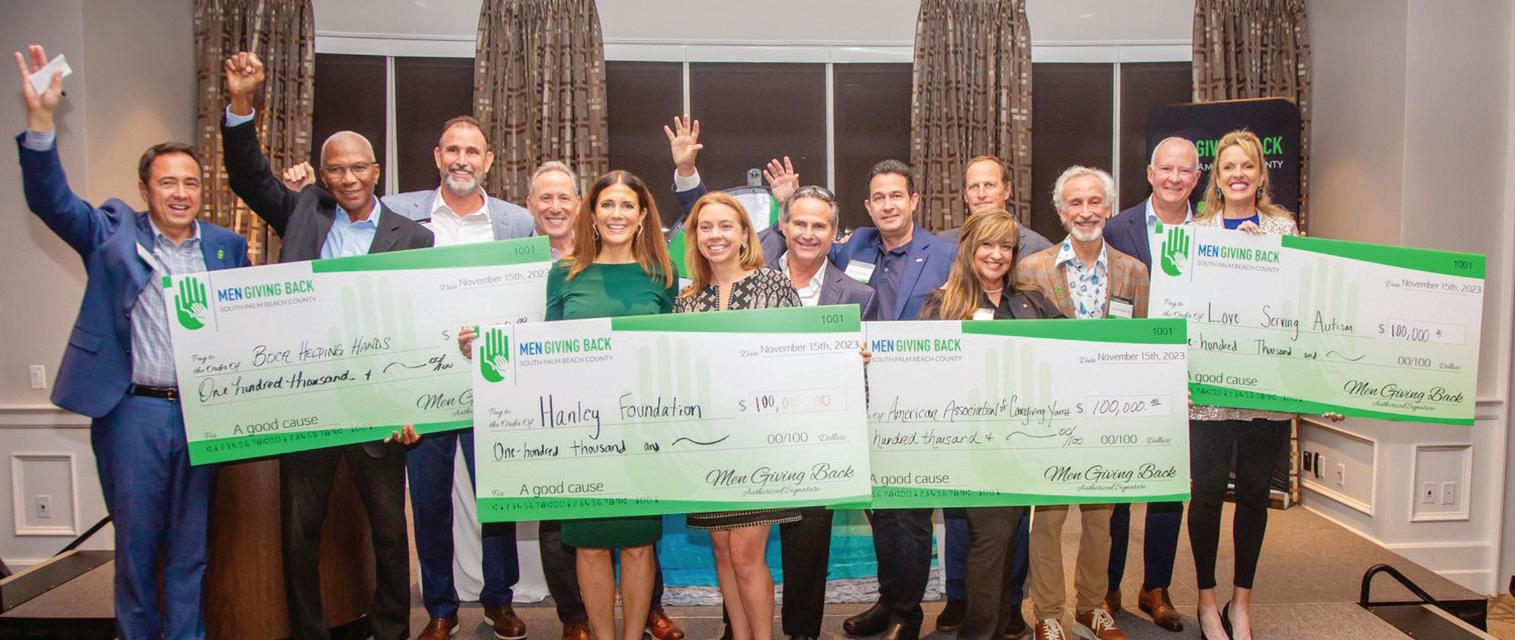
About Men Giving Back of South Palm Beach County : Men Giving Back of South Palm Beach County was conceived in February 2020 by a small group of motivated men from business, finance, health care, hospitality and law backgrounds. Fueled by the love for their community, the organization provides several South Palm Beach

“I am delighted to lead the Foundation during the Police Department’s Centennial year,” said Rose. “We are fundraising around this major milestone to help build the police force of the next century and have already engaged with many organizations and individuals wanting to contribute.”
County non-profits with grants. Nearly 100% of Men Giving Back member contributions go directly to the nonprofits they support. For more information, visit www. mengivingback.org. Follow the socials: IG @mengiving back; FB @mengivingbackpbc; LinkedIn.com/company/ men-giving-back.
Elaine Donholt • Ruth Nekoranec • Katie Heystek
Dianne Strout • Karen Kalisz • Michelle Feeney
Contributions to the Foundation last year resulted in the purchase of a Training Ammunition Combat (TAC) House for the Department. Costing over $200,000, it was the Foundation’s largest investment in its twelve-year history.
“We are appreciative of this generous gift, which will be installed soon within our training facility on Congress Avenue,” said Chief Michele Miuccio. “Once operational, officers will practice skills on how to better protect themselves and others during potentially dangerous situations.”
The Foundation’s ambassador group, The True Blue Society, will have its next event, “Thirsty Thursday” at Crazy Uncle Mike’s on March 27th.
About the Boca Raton Police Foundation. A charitable organization supporting the Boca Raton Police Department since its inception in 2013, the Foundation has raised and donated over $2.5 million to acquire equipment, technology and training for the Department. More details at bocarationpolicedepartment.org Contact: Bob Tucker, BRPF Executive Director, (561) 289-0436.


$1.8 Billion in sales. Top 1% of Coldwell Banker brokers. President’s Elite Award. 45+ years in real estate. The customer experience is the cornerstone of The De Marzo Luxury Group’s strategy. As a client-centric team, we have the distinctive expertise that helps sellers and buyers secure successful deals.
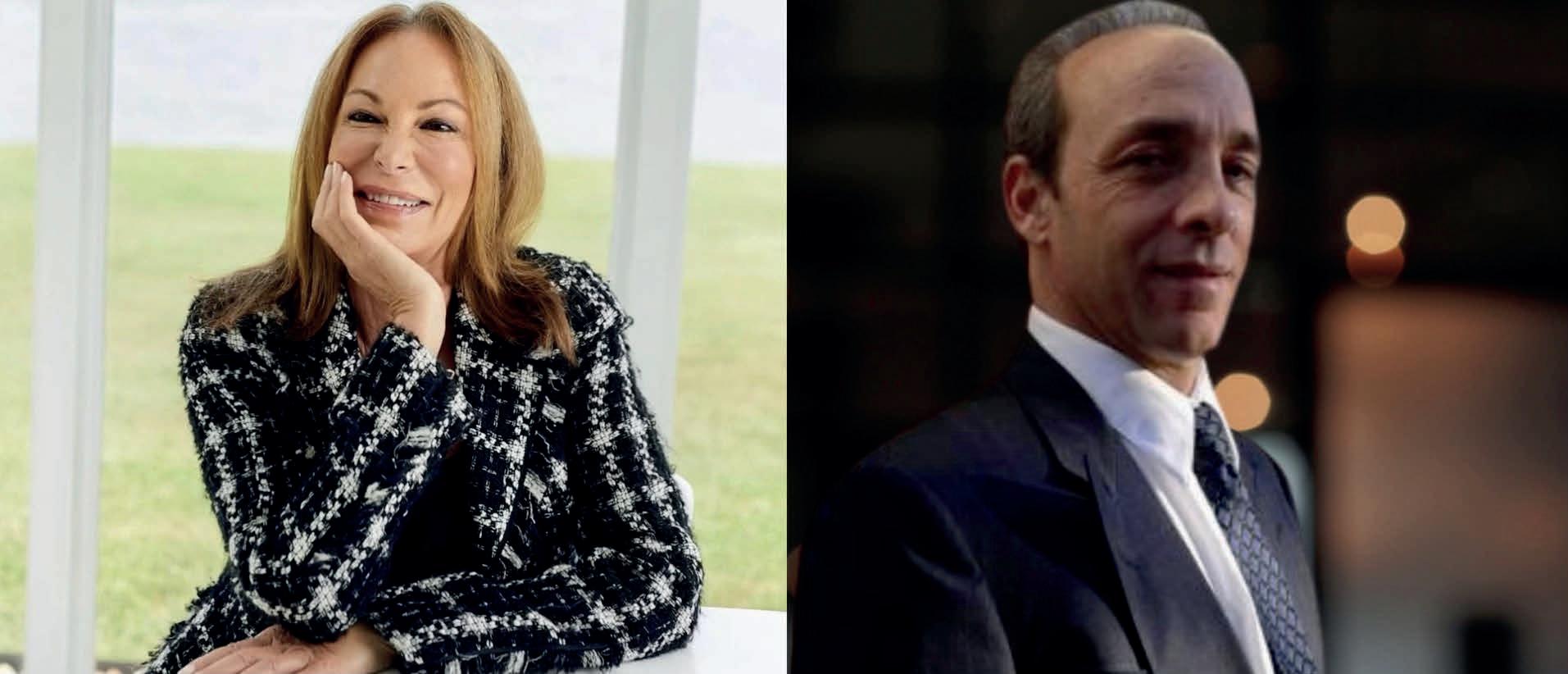
“It was a pleasure to have John De Marzo as my real estate agent. He sold our house in one month. He was very informed and always responded promptly.” - Michael T.
"Anne De Marzo has been our realtor for multiple home purchases and each time has worked tirelessly to get us what we really want. She goes the extra mile, is professional and knowledgeable.” - Brenda D.
2530 NW 52nd St., Boca Raton, FL 33496
4 Bed/3 Bath/2,200 SF Interior

Magnificently renovated two-story townhome with soaring ceilings, updated finishes, glamorous grandeur & outdoor oasis.
Price Improvement - $735K




3209 Clint Moore Rd. #205, Boca Raton, FL 33496
2 Bed/2 Bath/997 SQ Interior
Newly renovated move-in ready condo ideally located. Price Improvement - $349K



As experts in show & sell, The De Marzo Luxury Group is proud to share these stats from the last 12 months: 36 transactions closed
$28.5M in sales
Top-ranked small team in Boca Raton Everything We Touch Turns to Sold!
De Marzo Difference
Let us get the real estate results you need and success you deserve! We bring a steadfast focus and unique skill in home preparation, price setting, marketing campaigns, inspection guidance, and contract negotiations. With an intimate understanding of Boca Raton's distinct neighborhoods and country clubs, we craft bespoke real estate solutions that exceed client expectations. Contact a member of our esteemed team!
John De Marzo 561-445-7769
john.demarzo@cbrealty.com johndemarzorealty.com

Atim, Physician, Infectious Disease Specialist, 2023, chalk and mixed media on handmade paper. Courtesy of the Artist
While traveling in Italy in 2022, artist Donald Farnsworth—who was born in 1952 in Palo Alto, California and now lives and works in Oakland— was diagnosed with a life-threatening case of COVID-19. He was admitted to the Maggiore Hospital in Parma, Italy, where he was confined for five weeks. The exquisite portraits in a new exhibition on view through October 26th pay homage to the courageous doctors and healthcare professionals who risked their lives to save his during the height of the pandemic. While confined to the hospital, he took photographs of his

Giancarlo, Patient (Roommate) (detail), 2023, graphite, chalk and mixed media on handmade paper. Courtesy of Magnolia Editions, Oakland, CA
caretakers, treatments and fellow patients that he later used to make portraits upon his return to good health and the United
States. Though contemporary, Farnsworth’s mixed media drawings are made using traditional techniques and recall drawings made during the Italian Renaissance.
Especially pertinent to the exhibition of the Parma portraits, Farnsworth conducted painstaking research into the materials and techniques of papermaking during the Renaissance. The paper he made could have been used by Leonardo da Vinci. The use of Renaissance-style handmade paper to create the Parma portraits instills a timeless quality and mirrors the enduring values inherent to the medical profession.
“Donald Farnsworth: The Parma Portraits” exhibit will be accompanied by a full-color illustrated catalog. Kathleen Goncharov is the Senior Curator for the exhibition.
Admission: Members: Free. (Note: Year-long Museum Memberships start at $90.) Adults: $16. Seniors (ages 65+): $12. Groups: $10. High School Students (under 18): Free Children (under 15): Free.
Museum Hours: Wed, Fri, Sat, Sun: 11:00 a.m. - 6:00 p.m.; Thurs: 11:00 a.m. - 8:00 p.m.; Mon, Tue: Closed.
The Boca Raton Museum of Art will unveil in the coming months a lineup of exhibitions and events that bring together a diverse array of artistic voices and cultural experiences. From thought-provoking contemporary installations to historic masterworks, the museum invites art lovers, scholars and the community to immerse themselves in inspiration and exploration.
Featured Exhibitions
Glasstress. On View April 23rd–October 26th. A groundbreaking collaboration with Berengo Studio in Murano, Italy, Glasstress showcases the transformative power of glass as a medium for contemporary art. Featuring works by internationally acclaimed artists, this exhibition highlights the fusion of innovation and craftsmanship, pushing the boundaries of artistic expression through glass.
Modern Love: The Artist Couple Bernstein and Meyerowitz. On View May 14th, 2025–May 10th, 2026. This intimate exhibition explores the creative and personal partnership of renowned artists Bernstein and Meyerowitz. Through a selection of paintings, drawings and mixedmedia works, Modern Love delves into the intersections of art, love and collaboration, offering a unique perspective on their shared artistic journey.
Timeless Mucha: The Magic of Line. On View November 19th, 2025 – March 11th, 2026. Celebrating the legacy of Art Nouveau master Alphonse Mucha, this exhibition highlights the artist’s exquisite line work and iconic designs. Featuring rare drawings, posters, and decorative panels, Timeless Mucha transports viewers into a world of elegance and enchantment, showcasing Mucha’s enduring influence on art and design.
Special Events



Yoga at the Museum. March 16th and April 6th; 9:30 a.m. –11 a.m. Led by Leslie Glickman of Yoga Journey Studio, these sessions offer a rejuvenating blend of Vinyasa Yoga and artistic inspiration within the serene ambiance of the museum. Open to all experience levels, this practice encourages participants to connect mind, body and art in a revitalizing experience.
Artist at Work – Joseph Velasquez. March 22nd; 3 p.m. – 4 p.m. Renowned printmaker Joseph Velasquez shares insights into his artistic process, blending social activism with
storytelling. This session offers a rare opportunity to witness the creative process and explore the significance of printmaking as a means of cultural expression.
Music in the Museum –Borisevich Duo. March 23rd; 3 p.m. – 4 p.m. An afternoon of exquisite classical music featuring the internationally acclaimed Borisevich Duo. This performance will showcase masterworks by Brahms, Liszt, and Ravel, offering an intimate and captivating musical experience within the museum’s inspiring setting.
Lecture And Lunch Series


Presented by the Friends Committee, this exclusive series features distinguished speakers
offering insightful discussions on art and culture, accompanied by a delightful lunch.
● March 17th; 11 a.m. –1 p.m. Armando Droulers presents Paintings from the Spanish Golden Age, exploring masterpieces by El Greco, Velázquez, and Murillo.
● April 7th; 11 a.m. – 1 p.m.
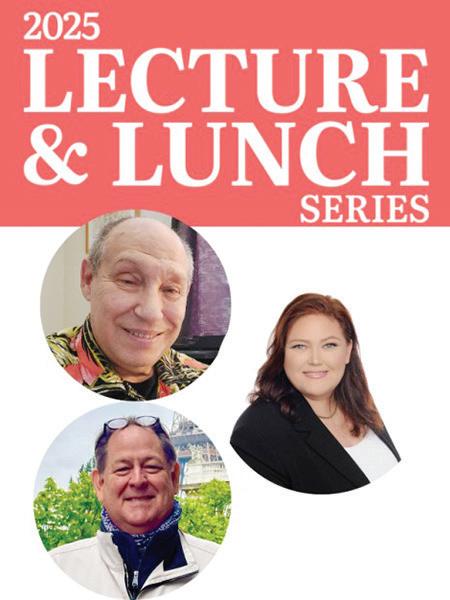
Laura Reich, Esq., discusses Fakes, Forgeries, and Frauds: International Intrigue in Art Law, examining famous art forgeries and the complexities of authenticity in the art market.
Tickets and Membership. Event ticket prices vary, with special discounts available for museum members. Membership provides exclusive access to events, exhibition previews, and other benefits. For more information on membership and ticket purchases, visit museum website or call (561) 392-2500.





In celebration of Youth Art Month in March, the Boca Raton Public Library presents a new photography exhibit, “Bobcat Vision: Boca Raton Community High School Student Photography.” Visitors to the front lobby area of the Downtown Library will be able to view a variety of photographs taken by the students in Boca High’s esteemed photography program.
Boca Raton Community High School has more than 500 students taking up to four photography and digital media courses for college credit through the College Board in the United States and Cambridge University in England. Students learn the elements and principles of art; how to properly use








cameras and photographic techniques and how to create and process their images using Adobe Illustrator and Photoshop. The students compete in, and frequently win, numerous photo contests. They also serve the school’s yearbook, newspaper and athletic programs.
“Visitors will be impressed with the high standard of artistic merit, creativity and expression in the diverse collection of photos from the Boca Community High School photography students,” notes Lisa Testa, Program Services
Librarian. “Congratulations to photography teacher Rob Sweeten for his ability to bring out the best in his students to produce exceptional photos for our community and for receiving a Palm Beach County proclamation declaring July 2nd, 2024, as Rob Sweeten Day in Palm Beach County.
“Bobcat Vision: Boca Raton Community High School Student Photography” will run through April 4th at the Downtown Library, 400 NW 2nd Avenue, during regular library hours.
As its own contribution to Youth Art Month in March, the Spanish River branch of the Boca Raton Public Library presents a new art exhibit, “Beauty of Life,” by Connie Chao. Miss Chao is a 16-year-old artist who aims to transform her personal journey of resilience into a mission of hope and beauty. Born with a heart defect, she faced significant challenges early in life. However, thanks to the compassionate care of hospitals like Joe


DiMaggio Children’s Hospital she was given a chance to see and embrace the “beauty of life.” As a heartfelt tribute to the life-saving efforts of medical professionals and a call to action she has used her art to raise funds for hospitals, ensuring that they can continue to help others see the beauty in life. In her art she aims to “capture the inspiring harmony of nature, reminding viewers of life’s preciousness and potential.”
Miss Chao says: “As an artist I view the world as a vibrant canvas where every moment and element of nature tells a story. The beauty of life, with its constant transformations, is what inspires me the most. My fascination lies in the interconnectedness between humans and nature and how we are not separate from it, but a part of its ever-evolving tapestry. With the use of bright colors I want to capture what I see and what I am a part of.”
“Beauty of Life,” a free exhibit, will run through April 11th in the second-floor Art Gallery at the Spanish River Library location, 1501 NW Spanish River Blvd, Boca Raton, FL 33431, during regular library hours.

The Cornell Art Museum’s new Spotlight Gallery exhibition, “Reflections by Andrés López,” features the works of this Cuban-born fine oil painter, muralist, Plein Air artist and arts educator. He paints marine landscapes while focusing on the wonderful effects of reflecting light and forms to create magnificent one-of-a-kind universes. The “Reflections by Andres Lopez” showcase includes 26 of his finest oil-on-canvas paintings, all of which explore life, its colors and reflections.
The exhibition, which will be on view through June 22nd, is free and open to the public. Donations are appreciated. Hours at the Cornell Art Museum are Wednesday 12 to 5 p.m.; Thursday and Friday 12 to 7 p.m.; Saturday 10 a.m. to 5 p.m., and Sunday 12 to 5 p.m.
The Cornell Art Museum is located at 51 N. Swinton Avenue, Delray Beach. Parking available in Old School Square garage.
The Cornell Art Museum is curated by Marusca Gatto, Cultural Arts Director at the Delray Beach Downtown Development Authority, in collaboration with Debby ColesDobay of Art Moves You.
Learn more about Andrés López at https://www. andreslopezfineart.com/.
About the Cornell Art Museum: The Cornell Art Museum is housed within the original Delray Elementary School building, which was built in 1913. The Museum hosts several curated fine art exhibitions each year featuring notable regional, national and international artists. It also has a Museum Store displaying original works by regional artists. The City of Delray Beach purchased the historic building on the Old School Square campus from the Palm Beach County School District in 1987. The building was named after benefactors George and Harriet Cornell in 1990, before being renovated in 2017 through the generous support of Margaret L. Blume. Learn more at https://delrayoldschoolsquare.com/about.
About Old School Square: Old School Square is a historic cultural arts campus in the heart of Downtown Delray Beach. Old School Square’s mission is to create a welcoming space where the community comes together for high-quality, diverse and interactive art experiences, while honoring the 100-yearold historic campus. The 6-acre campus is home to early 20th century school buildings that have been renovated and are now a fine arts museum (Cornell Art Museum), wedding and events venue (The Vintage Gym), and a performance theatre and creative arts school (Crest Theatre building). The campus also boasts an outdoor amphitheater for live music performances, a park and its own parking garage. Old School Square takes up an entire city block at the corner of Atlantic Avenue and Swinton Avenue. The address is 51 N. Swinton Avenue, Delray Beach, FL 33444.
For a full list of events happening at the Cornell Art Museum, visit https://delrayoldschoolsquare.com/cornell or call 561-654-2220.
From Lily Langtry to Cyndi Lauper and Betty Boop to Tina Turner, or from Rosie the Riveter to Britney Spears, female singers and pop stars and their music provide a vivid reflection of how much has changed for women since the beginning of the 20th Century. “Respect: A Musical Journey of Women,” the fourth production of the Pompano Players’ inaugural season, will open on March 28th at the Pompano Beach Cultural Center and run through April 6th.
The show featuring an ensemble cast of four (Dalia Aleman, Noelle Nicholas, Heather Simsay and Anneliese Wolfanger) and a live band, and combining excerpts from 60 songs–including Someone to Watch Over Me, I Will Follow Him, These Boots are Made for Walking, What’s Love Got to Do with It and Brave—with women’s own stories about finding dreams, lost love, relationship issues, entering the workforce, gaining independence and more, “Respect” has resonated with audiences around the world. Men as well as women have no trouble at all identifying with the messages of encouragement and empowerment that the production portrays.


“‘Respect: A Musical Journey of Women’ is more than just a jukebox musical; it is a celebration of resilience, empowerment and the evolving role of women through the decades,” says the show’s director, Jeremy Quinn. “Through the powerful lens of music this production tells the story of struggle, triumph, love and identity, all woven together by the unforgettable songs that defined generations.
“Above all, ‘Respect’ is a celebration of the collective strength of women. It is a reminder that music has the power to inspire, to heal and to unite. I am honored to bring
this journey to life on stage and to share in this tribute to the voices, past and present, that continue to demand—and deserve—respect.”
The show will run from March 28th through April 6th at Pompano Beach Cultural Center, located at 50 West Atlantic Boulevard, in Pompano Beach. Performances: Fridays and Saturdays at 7 p.m., Saturdays and Sundays at 2 p.m. Tickets range in price from $45 to $65 and may be purchased online at https://pompanobeachculturalcenter. com or by calling (954) 501-1910.
Celebrating its 15th anniversary, inSIGHT Through Education is a nonsectarian, nonprofit organization committed to inspiring and educating individuals through the lessons of the Holocaust and other genocides. With a mission to combat prejudice and foster respect and acceptance, inSIGHT empowers students, educators, and communities to build a more inclusive world.
Since its founding in 2010, inSIGHT has been the primary funder of Holocaust education in the Palm Beach County School District, one of the nation’s largest. In the 2023/24 academic year alone, the organization reached 40,000 students and trained more than 400 educators, equipping them with the tools to teach history with meaning and impact. inSIGHT has provided $1.9 million in educational programs over the past 14 years, underscoring its commitment to fostering kindness, acceptance, and respect among students.
Looking ahead, inSIGHT aims to expand its reach to 75,000 students and educators in the 2024/25 academic year, striving to bring Holocaust education to every student, every year, across over 180 schools and nearly 200,000 students in Palm Beach County.
Join Us For inSIGHT OUT – A Day Of Inspiration And Impact
To support its initiatives, inSIGHT Through Education is hosting “inSIGHT OUT,” a signature fundraising event on Monday, March 17, from 9:30 a.m. to 4:30 p.m. at the Palm Beach County Convention Center.
This dynamic, full day of engaging activities will bring together like-minded women from across the community for thought-provoking conversations, an exclusive shopping boutique, a luncheon, and

card play. The event will feature keynote speakers Lizzy Savetsky and Tanya Zuckerbrot, two extraordinary women who use their platforms to drive meaningful change and inspire action. Tickets are priced at $250 per person.
To purchase tickets for the inSIGHT OUT event, please visit insightthrougheducation.org/insightout. Early registration is encouraged, as demand for this event is expected to be high!
By attending inSIGHT OUT and supporting inSIGHT Through Education, you are investing in the power of education to combat hate, promote understanding, and create a future rooted in respect and acceptance.
Learn more at insightthrougheducation.org.


Scott Singer is the 35th Mayor of Boca Raton and was re-elected in 2023.
A South Florida native, attorney, mediator, and small business owner, Scott and his wife Bella live in Broken Sound with their two young children.
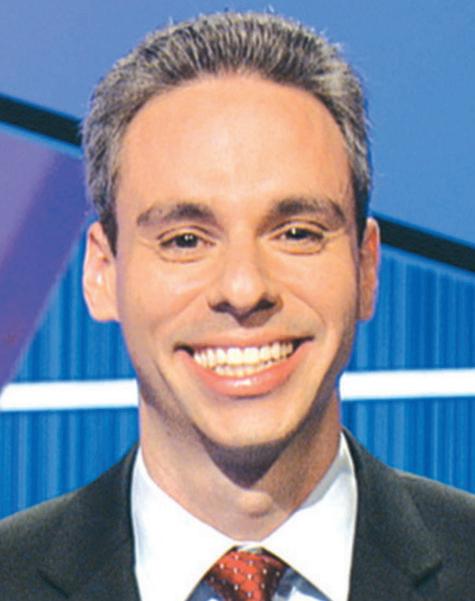
Boca Raton is proving itself to be a shining beacon of athletic excellence, with our local teams and athletes bringing home national titles and helping to solidify the city’s reputation as a premier sports hub.
With March Madness on the horizon and memories of Florida Atlantic’s recent exciting Final Four run, it is exciting to recognize all the achievements our city has accomplished in the sports world. This past year has seen victories across multiple disciplines, further showcasing the city’s dedication to fostering talent and athleticism.
Pickleball Dominance: Boca Raton Picklers Shine. In a thrilling showcase of skill and teamwork the Boca Raton Picklers recently captured the National Pickleball League championship, marking a historic achievement for the city.
The team, known for its relentless drive and sharp focus, battled through fierce competition to claim the coveted title. This victory also highlights the growing popularity of pickleball in the area. The city recently approved the addition of several new pickleball and padel courts. One project plan turns 28,356 square feet of industrial space on Holland Drive into eight courts. Another project will bring indoor pickleball courts to North Park. As the sport continues to expand we will be on the lookout to watch the Picklers and other teams.
Lynn University: A Powerhouse in Collegiate Sports.
Lynn University has long been known for its academic prowess, but its athletic programs have also been making waves on the national scene. The men’s soccer team recently clinched the national championship, showcasing a blend of skill, discipline and teamwork. The victory marked a significant moment in the program’s history, and the team’s triumph has further solidified Lynn’s reputation as a top-tier athletic institution.
Not to be outdone, the Lynn University women’s volleyball team also delivered an unforgettable performance, securing their own national championship. Their resilience
and athleticism were on full display as they outlasted their opponents in an intense final match, bringing home the title in a historic win that will be remembered for years to come.
A City That Supports Its Athletes. What makes these victories even more remarkable is the support and infrastructure that Boca Raton provides to its athletes. With exciting changes coming to our downtown government campus, the city will be looking at ways to enhance its offerings.
While there will be changes in store for where many enjoy playing tennis, softball and skateboarding we are looking at making upgrades to ensure our residents have access to topnotch quality recreation offerings. Our city rallies behind its athletes from the littlest sluggers to the adult leagues. We cheer for sportsmanship and excellence and the City of Boca Raton’s commitment to recreation is clear.
As we look ahead, the future of Boca Raton’s sports scene is brighter than ever. With a combination of rising talent, dedicated athletes and a community that supports them, it’s no wonder that the city continues to shine on and off the field.

By Andy Thomson, who was reelected to the City Council at the last election after having previously served from 2018-2022. He has lived in South Florida his entire life, except for four college years in Atlanta. Andy resolves business disputes for a living. He is also an adjunct professor at FAU, where he teaches local and state government. Andy and his wife, Joanna, have five young children.
Back in 2021 we started the RunTheCity initiative, when we resolved to run every mile of every street in Boca Raton—all 475 miles of them—while cleaning up trash. We accomplished that goal and kept going. We’re now on round 2 around the City of Boca Raton and still working to make our streets safer and cleaner.

A few months ago, we decided to add to that another ambitious mission: to kayak and clean up trash from all 77 miles of waterways in the City of Boca Raton over the course of a year. We have done ten “kayakleanups” so far. My son Henry points out trash and fish (and is crushing it) while I paddle and clean. So far we’ve covered 15.78 miles, cleaned up 46.4 pounds of trash and identified two waterway improvements, so we’re off to a great start. Henry has also
caught 16 fish—some snook, catfish, cichlid and pufferfish. It’s a great way to see a different side of our city. If you want to participate (by kayak, paddleboard or boat) to help keep Boca Raton’s waterways clean, we would love to have you! Please reach out to us at (561) 221-4675 or Thomson@myboca.us. And we hope to roll out some related initiatives over the next few months, so stay tuned!





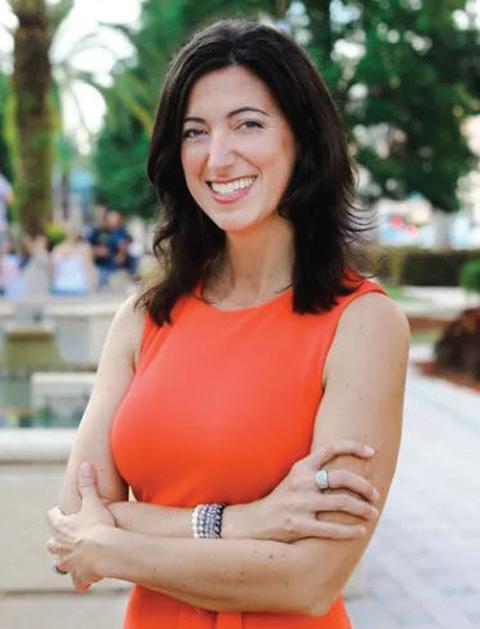
Commissioner Woodward, a 20-year resident of Boca Raton, was elected in November 2023 as Palm Beach County District 4 Commissioner. She serves on the following boards of directors as a representative of the county commission: Palm Beach Transportation Planning Agency; South Florida Regional Transportation Authority (TriRail); Treasure Coast Regional Planning Council; CareerSource Palm Beach County; Palm Beach Cultural Council and Value Adjustment Board. Ms. Woodward graduated from the University of South Carolina-Aiken with a Bachelor’s Degree in Fine Arts.
Last November I attended the Joint Annual Conference between the Treasure Coast and South Florida Regional Planning Councils at FAU, where the topic was “The Silver Tsunami.” One of the speakers, Angela Antonelli, executive director of the Center for Retirement Initiatives at Georgetown University, spoke on the work being done around the country for employees of small businesses to have access to retirement plans.
Although the conference focused on senior citizens’ struggles, it was important to bring attention to the need to help current workers better prepare for retirement. It was a fascinating discussion I could not shake from my mind. I contacted Angela afterward and we discussed ways to bring this initiative to Palm Beach County. She invited me to be a panelist at the 2025 Annual Conference of State-Facilitated Retirement Savings Program in Nashville at the end of January. The conference brought together state leaders from around the nation to discuss improving retirement readiness for small businesses and their employees.
I was fortunate to have Sherry Howard, division director for Palm Beach County Housing & Economic Development, and Tammy Fields, assistant county administrator, join me to make sure we could absorb all the valuable information from this trip. Their expertise and participation were invaluable, not only in expanding our network but also in gathering data to support our county’s business community.
The best way to move this process forward is to begin with the backing of local business and economic development stakeholders. The second takeaway is the need to have this taken up as legislation at the state level. There are more than 20 states that have either passed or are in the process of implementing legislation for state-facilitated plans. Much of the hard work has been done, and the conference in Nashville proffered several individuals and organizations ready to help us in Florida.
As a county commissioner I do not make policy at the state level, but I recently hosted a meeting with many community stakeholders at the Canyon Branch Library to discuss an important idea for Florida. Angela Antonelli spoke on this issue and Nathan Glassey, Director of Federal and State Legislative Affairs at the American Retirement Association, was also in attendance. During the meeting they shared their findings and highlighted the urgent need to address the retirement savings gap within our workforce. An alarming 56 million U.S. workers, representing over 60% of the private sector, currently lack access to employer-sponsored retirement benefits.
During this discussion representatives asked hard questions, rigorously dissecting the proposed program to understand how it could successfully work for our county. They dug into the details, showing they’re serious about finding a solution that works.
Small businesses, which form the backbone of Florida’s economy, face unique challenges in providing retirement options. Many find it cost-prohibitive or too burdensome to “shop” plans for themselves and their employees. Many business owners work as many if not more hours than their employees and simply do not have the time to tackle one more thing. In fact, 73% of employees in small businesses with fewer than 50 employees lack access to retirement savings plans through their jobs.
Here in Palm Beach County we have a total of 72,146 businesses, with a staggering 97%, or 69,885 businesses employing fewer than 50 people. These small businesses are the lifeblood of our local economy, employing almost half the workforce. However, a significant portion of these employees, approximately 305,218 individuals, lack access to retirement plans.
The state-facilitated programs, often utilizing an Auto-IRA model, allow businesses to automatically enroll employees in retirement savings accounts with minimal administrative burden and no direct cost to
employers beyond payroll deductions. Employees retain the flexibility to opt-out at any time. The plan is also extremely portable in that it easily follows the employee if they change jobs within the state.
I am encouraging our business community to actively advocate for a state-facilitated retirement savings program in Tallahassee. The benefits are clear and compelling. By establishing such a program we can significantly improve the financial security of our workforce, reduce reliance on public assistance and alleviate pressure on programs like Social Security.
This is a strategic investment that will benefit employers, employees and taxpayers alike. If you’d like to learn more about this or offer your help, please contact us. It’s time to get some traction in Tallahassee on this important issue.
A big thank you to Angela Antonelli and Nathan Glassey for taking the time to speak with our business community. I’m excited to see where this conversation will take us and to get the ball rolling!
New Agenda Items. Each month, the Board of County Commissioners approves a wide range of important agenda items that impact areas such as engineering, facilities, housing, airports and more. Here are some key items approved this month:
Increase the Agricultural Enhancement Council (AEC) from 9 to 11 members and remove term limits. New members will include a representative from small farms (under 50 acres, outside the Everglades Agricultural Area and Agricultural Reserve) and one from agri-tourism, recommended by the Palm Beach County Farm Bureau.
Clerk Joseph Abruzzo announced a record-breaking investment income of $230 million, surpassing last year’s previous high of $173 million. He projects returning over $1 billion to taxpayers during his eight-year term.
The following companies by a 6-1 vote to provide EMS services in Palm Beach County from February 11th to June 30th, 2027: MCT Express, Inc. (All County Ambulance), National Health Transport, Inc., Positive Mobility Inc. (Elite Medical Response), and E-Care Ambulance, Inc. Palms West Hospital (HCA Florida Palms West) is limited to transporting patients between the hospital and other facilities.
A contract for the operation and maintenance of the baggage handling systems at Palm Beach International Airport (PBI) has been extended for an additional year. The amendment increases the contract amount and allocates funds for the replacement of two more baggage claim carousel units.
The Florida Inland Navigation District (FIND) Project Agreement provides up to $917,950 for the design, permitting, construction and monitoring of the South Lake Worth Inlet Sand Trap and Boat Channel Dredging Project, effective upon signing and ending by September 30th , 2026. Additionally, a transfer of $2,191,391 will bring the total funding to $3,109,341.
Safe Street Summit. I was thrilled to be part of this year’s Safe Street Summit, organized by the Palm Beach Transportation Planning Agency. The event kicked off with the New District & Urban Connections Tour, where we got an inside look at Nora – downtown West Palm Beach’s vibrant new adaptive reuse and development district.
The following day, we dove into discussions on best practices and infrastructure improvements that can make a real impact in our communities. It was also a proud moment for Palm Beach County, as we were honored with the Community Award. A big congratulations to Mayor Michael Napoleone on receiving the Complete Streets Champion Award!
Art in Motion. Michael Woodward and I had an amazing time attending a preview of the 2025 International Kinetic Art Experience with the City of Boynton Beach. The event brought together creativity and engineering in a truly inspiring way. A huge thank you to Catering Solutions for generously providing a delicious breakfast to kick off the day and to everyone involved in bringing this incredible experience to life. Over the weekend more than 30 artists from around the globe displayed their innovative works, highlighting various styles and dynamic movements. The event also featured artist talks, family-friendly art activities, live music by the Valerie Tyson Band, food trucks, and much more.
BDB Luncheon. The entire board was in attendance at the BDB luncheon, where we had the privilege of hearing from Armando Pimentel, president and CEO of Florida Power & Light (FPL). He shared insights on how FPL has been a driving force in building strong communities for nearly a century.
I had the opportunity to meet four amazing companies that have expanded or relocated to Palm Beach County, creating hundreds of jobs and contributing millions in capital investment. These companies include Bee Access, HOERBIGER, Celebree School, and BAC Fabrication LLC & BAC Consulting. Their growth is a major boost to our local economy.
The Hands and Feet is a local nonprofit that serves as a vital resource for children and families navigating the complexities of the child welfare system. Acting as a sort of “DoorDash for foster care,” they swiftly deliver essential items, from clothing and diapers to car seats and comfort items, addressing immediate needs and offering crucial support.
More than just providing tangible goods, The Hands and Feet extends a lifeline of hope and community, ensuring that vulnerable children and families know they are not alone. Their dedication to filling the gaps and providing for those in crisis makes a tangible difference in the lives of many within our community.
Palm Beach County has a Home Rule Charter? As a resident of Palm Beach County, you might have heard the term “Home Rule Charter” but may not fully understand what it means or how it affects you. Let’s break it down in a simple way!
The Home Rule Charter is like the “Constitution” of our county. It sets the framework for how our local government operates. Essentially, it outlines how decisions are made, how elected officials do their jobs and how we, the people, are represented.
This governing document gives Palm Beach County the authority to govern ourselves without needing approval from the state for many local matters. It helps us tailor our government to fit the unique needs of our community. By establishing clear rules for governing, it ensures transparency, fairness and accountability.
Here are key elements:
Government Structure: The local Constitution outlines how the county is governed, including the roles of the Board of County Commissioners and the county administrator. We elect commissioners to make decisions on our behalf and the administrator is responsible for running day-to-day operations.
Elected Officials’ Responsibilities: It explains what each elected official, including the commissioners, can and cannot do, and the procedures for how we vote on county matters.

By Dale Brown, B.S., M.A., C.E.C.

Dale is a motivational speaker who has spent many years as a Certified Life Coach and has written numerous articles and e-books relating to selfimprovement and ways to build a high-performance team. She is the author of the book, “Small Steps... Big Changes: The Personal Stories of a Life Coach.” Her education and years of experience in physical fitness and training of elite athletes has enabled her to sharpen her knowledge in many health-related areas. The following introduces a new approach to Ms. Brown’s series of columns devoted to many topics that deal with the mind/body connection and the importance of living a healthy lifestyle. Dale, a Bocaire resident, can be reached at dalebrown@lovingmondays.com.
We all want to be healthy and know how important it is to eat a balanced diet rich in fruits, vegetables, whole grains and lean proteins. This is nothing new. You hear it from your doctor; read about it in magazines and listen to it on TV. I have long been an advocate for making healthier lifestyle choices, including the foods you eat. As much as it seems simple, for some people it may be harder than you think.
Eating disorders are on the rise, reflected by the staggering statistic that approximately 29 million Americans will have an eating disorder in their lifetime. You might be familiar with the most common ones, such as anorexia, bulimia or binge eating. When working as a gymnastic coach in a previous chapter of my life I saw first-hand what an eating disorder looked like and it wasn’t pretty! Food for these young athletes became an enemy. Their only course of action for staying lithe and fit was to deprive themselves of proper nourishment to the extent that it became life threatening.
Now there’s a new eating disorder to add to the mix. It’s called orthorexia. And yes, it’s another obsession that individuals place upon themselves with good intentions. Except, like any obsession, things lead to overkill and become a problem more than a solution. In this disorder the main focus is on consuming foods that are classified as “pure” or “clean.” Their main objective is to choose foods that are healthier and improve their chance to live longer.
So, you ask yourself, “What’s wrong with that”?
Nothing is wrong…until it turns into an all-consuming preoccupation with what’s “healthy” and the avoidance of foods they deem “unhealthy.” This obsession interferes with their ability to put the importance of food in perspective to other parts of their life. When that happens they begin to stress over how to make the “right” choice of when and what to eat. In time this fixation may result in psychological problems with social consequences.
Some examples of orthorexia disorder might be:
Fixation over quality of food: They may fear falling ill if they consume foods that are unsanitary or unclean. As a result they find ways to excuse themselves from going out socially or sit at the table claiming to have just eaten. If given the option of eating something they deem unhealthy they would rather not eat.
Inflexible eating pattern: They become very inflexible about eating and may refuse to eat anything that might be on the menu or banquet table. In extreme cases they may skip social events due to the fear of the food being served. They may use a common avoidance technique and isolate themselves, which may lead to depression and loneliness.
Constant worry about sickness or disease: Feelings of distress, shame or guilt if they stray from their rigid eating pattern. They deem some foods as “bad” and
By Michael J Posner, Esq.,
a partner in Lippes Mathias LLP, a national real estate and business-oriented law firm with sixteen locations nationwide. Michael specializes in real estate and association law. He can be reached at (561) 594-1452 or at mjposner@lippes.com

A CPA once told me that I should never fear a thick envelope from the IRS. It was the thin envelopes that should worry you the most. One couple received the dreaded slim envelope, as detailed in a recent Moneywise article headlined, “This Florida couple bought the ‘perfect house’ from foreign nationals — months later, they received a $30,000 fine from the IRS.” The fine arose from their innocent purchase of a house from foreigners and will likely cost them substantial time and money to resolve the issue.
The article details how a family bought their dream home for $790,000 in 2020 from two Russians who had built the home. Under the law, foreign sellers of real property are required to have a portion of their sales proceeds paid to the United State Internal Revenue Service from their closing proceeds, regardless of whether they made a profit on the sale. The percentage varies depending on the amount of the sale and the type of property being sold.
If the Buyer intends to reside in the home in question and the sales price is less than $300,000, then there is no




amount due to be withheld. If the Buyer intends to reside in the home in question and the sales price is between $300,000 and $1,000,000, the amount withheld is ten percent. For all other transactions the withholding is fifteen percent unless the Seller is a foreign entity in which case withholding is usually twenty-one percent.
Buyers need to realize that while the withholding is meant to come from the Seller’s proceeds, a Buyer is one of the parties responsible to ensure that the proper amount is withheld. The Foreign Investment in Real Property Tax Act imposes the withholding obligation on the Buyer, not the foreign Seller. The reasoning is that collecting the tax due from a foreigner in a foreign country is far harder than making the Buyer withhold the money at closing.
In the case described above, the attorney for the Seller did withhold the required ten percent, but he failed to remit same to the IRS within twenty days of closing as required by law. Instead, he waited nine months to remit, resulting in a penalty for failing to withhold and remit equal to $30,000. While the lawyer was liable for the negligence in not timely remitting the withholding amount, the Buyer was liable as well, and if they could not get the attorney to pay the penalty the IRS would have been legally able to recover the penalty directly from the Buyer (which the lawyer eventually did pay).
Not only is a buyer liable for possible penalties, if a Buyer fails to withhold from a foreign seller they can be liable for the actual tax due from the sale. Therefore, a buyer must be aware that if a Seller is foreign to make arrangements in advance to ensure that the proper sum is withheld and the proper forms are prepared so as to properly remit the withholding sum to the IRS.

believe if eaten will cause disease and consider these foods to be poison. They may feel uncomfortable and leave the room to avoid looking at certain foods being consumed by others.
Cutting out entire food groups: A common occurrence for this population is to completely eliminate processed foods, sugar, meat, dairy products, carbs and/ or gluten.
Orthorexia comes in various degrees, like many disorders. But extreme behavior may reach a point where the quality of life is jeopardized. The fear is that food not deemed as “clean” must be “unclean.” This conjures up a nasty image of what you put in your mouth, thereby limiting your food choices. Clean eating advises choosing only food as close to its natural form as possible, such as organic, uncured and unprocessed. As much as this seems sensible, it can get way out of hand.
The function of healthy eating is choosing foods that are best for you and that support overall wellbeing. It may seem so basic that you might not need instructions. Yet, based on the current trends it might be a good time to rethink your approach to everyday eating habits. Dietary guidelines recommend that 85% of the food you eat should nourish your body, leaving the rest for foods you find fun and indulgent.
“There is a time and a place for French fries and pizza and a piece of cake.” Dining is meant to be enjoyable and important to many cultural and social events. Sharing a meal with family and/or friends is one of the many joys in life. Enjoy the company you’re with, along with the freedom to choose foods that are both satisfying and nourishing. If you or someone you know shows signs of, or needs help with, an eating disorder, please consult your health care professional for guidance or recommend someone to do so.
The standard Far/Bar Real Estate Contract, used in most closings in Florida, specifically warns that “Section 1445 of the Internal Revenue Code (“Code”) requires the Buyer of the real property to withhold up to 15% of the amount realized by the Seller on the transfer and remit the withheld amount to the Internal Revenue Service.” In addition, the Contract requires that the Buyer, “Upon remitting funds to the IRS pursuant to this STANDARD, Buyer shall provide Seller copies of IRS Forms 8288 and 8288-A, as filed.”
This means that it is both the Buyer’s obligation to withhold the tax and to prepare the necessary tax forms to remit the tax. This is an expense that many Buyers are not aware of and usually runs between $1,000 and $2,000 for a lawyer or CPA to prepare. In addition, issues can arise if a Seller does not have enough equity from the sale to pay the remittance. For example, a house sale of $500,000 to a Buyer planning on living in the house would require a $50,000 withholding remittance. If the Seller owes $420,000 on a mortgage and $10,000 in taxes after real estate commissions and closing costs, the Seller will be short at least $30,000 due the IRS. A Buyer simply cannot close if the Seller does not have an alternate source to cover this shortfall.
Buyers need to ask Sellers if they are deemed a foreign person before signing any contract. Buyers should also require the Seller to cover the cost of withholding. Failure to properly vet a Seller can be a costly mistake for a Buyer. That is why Buyers should always have a good real estate lawyer representing them on the purchase of property from foreigners to ensure that the withholding is done properly to avoid the possibility of taxes and penalties on improper handling of FIRTPA eligible transactions.

By Richard Nagler,
M.D., a member of Broken Sound Club and retired physician. After graduating from the University of Pennsylvania and New York University’s School of Medicine, Dr. Nagler served his internship and residency at Baltimore City Hospital and Johns Hopkins. He followed that with a Fellowship in Gastroenterology at Yale University School of Medicine, and was then Chief of Gastroenterology at Fitzsimons General Army Hospital in Denver. He returned to the Yale Medical School for one year as an Assistant Professor of Medicine before opening his own successful private practice in Internal Medicine and Gastroenterology. During that time, he also served for ten years as Chief of Medicine at Huntington Hospital in Huntington, N.Y.
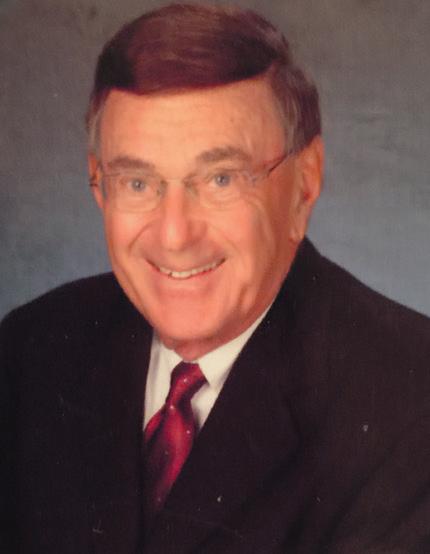
In this century, through extensive research and advanced technology effective medical care has advanced to a remarkable degree. Much of it has been due to prevention of disease and it is the development of safe and effective vaccines that is mainly responsible.
To understand how important vaccines are a review of several pandemics that have afflicted humanity is noteworthy. In the 20th Century smallpox caused by a virus killed 300 million people worldwide before being eradicated after the development of a vaccine in 1979 by Edward Jenner. It was made from a live virus (cow pox) which is like smallpox but does not cause disease and produces completely protective antibodies against it.
Polio is a viral disease that afflicts mostly children. It is spread from person to person mainly from contaminated food or water Although only 2% (500,000) of those afflicted either died or were permanently paralyzed when the virus attacked the central nervous system, it was particularly devastating for those who were resigned to life in an iron lung. In 1953 Jonas Salk introduced an injectable vaccine containing a formaldehyde inactivated virus approved by the FDA in 1955 that proved to be 99% effective in preventing polio.
This was followed by the introduction of the equally effective Sabin oral vaccine in 1960 but which has since been mostly abandoned. However, in 1955 200,000 children in the west and Midwest were given the Salk vaccine and 40,000 developed polio. Ten died and 200 developed paralysis. The cause was a defective process of inactivation of the virus in the vaccine and as a result all polio vaccinations were suspended temporarily. This was a major factor in the public’s fear and distrust of vaccines and led to strict federal regulation of all vaccines which as a result now enjoy an unmatched record of safety as compared to any other medical product.
However, Polio has not been eradicated which is why it is strongly recommended that all children are vaccinated with four separate Salk vaccine injections starting at two months and then up until entering elementary school.
The Spanish flu pandemic in 1917-1918 was the deadliest in human history. It infected 500 million people (one third of the world’s population) with 50 million deaths. In the USA there were 675,000 deaths, many of whom were in the 20-to-40-year age group. It was caused by an avian flu virus known as H1N1. There was no effective treatment and no vaccine. The pandemic ran its course and abated after two years due to the development of herd immunity as survivors developed antibodies which offered protection against the virus.
However, it never entirely disappeared, morphing into various strains that today are represented by seasonal flu. Over the past 10 years, depending on the year there have been in the USA 45 million flu illnesses, 140,000-810,000 hospitalizations and 12,000-61,000 deaths annually. While there is no cure there are antiviral drugs such as Tamiflu which if taken early in the course of the disease can lessen the severity and duration of it. A flu vaccine was first developed and introduced in 1945-1946. It is made from killed or inactivated viruses as a trivalent vaccine containing three strains of the A and 1 of the B. There is also a quadrivalent vaccine available which includes a fourth strain of the B virus. Because of a weaker immune response to the vaccine by seniors they are advised to get a dose four times higher than the standard amount. The risk of getting the flu from the vaccine is zero. The vaccine has proven to be effective in preventing the flu in 40-60% of people each year depending on whether the circulating strains of the virus that year are included in it.
But immunity weakens after a year and new mutated strains appear so it must be revised and administered annually. For those for whom it fails to prevent the illness most of them will get a milder disease with far fewer complications, especially pneumonia.
Unfortunately, each year an average of only 48% of Americans get vaccinated which is why there are so many hospitalizations and deaths. For example, in the 20182019 epidemic in the USA 35 million people got the flu, 490,000 were hospitalized and there were 34,200 deaths. Interestingly, fears of the flu occurring simultaneously with Covid 19 which would complicate making a correct diagnosis has proven to be unfounded because the incidence of the flu has been remarkably low.
The reason is probably the result of all the mitigation efforts against Covid 19 with wearing masks, social distancing and good hygiene.
On a positive note, there is active intense research going on using the new technology to develop a universal flu
vaccine which would be effective against all strains and mutations of the virus and provide long lasting immunity. It is estimated that this may be achieved in 2 years.
The Covid 19 pandemic has already been reported in over 100 million cases in the United States with more than 1 million deaths. Although the number of new infections has significantly diminished, Covid infections continue to occur all over the country with the number of cases increasing again. Vaccines were developed in a remarkably short period of time especially for seniors and the most vulnerable, and they have had a profound impact on reducing serious complications, hospitalizations and deaths. The 2 vaccines authorized by the CDC and NIH are very different from previous antiviral vaccines which are basically made from attenuated killed viruses. They use mRNA (messenger RNA), a major achievement in immunology which teaches our cells to make a protein that triggers an immune response with antibodies and T cells against the spike protein on the surface of the corona virus which is responsible for its ability to penetrate our body’s cells and cause infection.
The risk of the vaccine causing viral infection is zero as there is no virus in it. However, after several months the antibody levels achieved by these vaccines begin to ebb so that after 6 months booster shots are strongly advised. Because the Covid virus mutates frequently updated bivalent booster shots have been developed that produce more antibodies against these new variants. There are side effects including pain and redness at the injection site, low grade fever, fatigue, chills, headaches, muscle aches and joint pain subsiding after several days. In very rare cases anaphylactic reactions which can be life-threatening have been observed in people who have had such reactions in the past.
There is no doubt that the miracle of vaccines has saved millions upon millions of lives worldwide and prevented pain and suffering from diseases that would have afflicted millions more. Unfortunately, there are many antivaxxers in this country who doubt and object to tried and proven effective and safe vaccines such as polio, measles, pertussis (whooping cough), chicken pox, mumps and both hepatitis A and B. Often they have been accused of being stupid, but I think otherwise. It is that they are ignorant due to believing in misinformation abetted by a distrust of the federal government, drug companies, science in general and the medical establishment. Religious beliefs, infringement on human rights and especially refusal to accept the debunked link of vaccines to autism are often blamed.
These antivaxxers have formed organizations such as “Stand for Freedom” encouraged by politicians like Robert Kennedy Jr. rejecting the government’s telling them how to care for their bodies and keeping its hands off their children. I doubt that most of these antivaxxers have any relationship with a trusted doctor who could dispel their doubts and convince them of the vital importance of vaccinations.
The remarkable achievement of developing these mRNA vaccines gives us the opportunity of using this same technology to quickly develop them to immunize the public when the inevitable next viral pandemic comes.

By Alan Serinsky of Bocaire Country Club.

Hungry Al’s love for food started very young. Never satisfied with his Mom’s dishes, he started to cook his way through her “Betty Crocker Cookbook.” During the years to follow he spend many hours working in restaurants, both as server and cook, attending cooking classes and traveling the world in an effort to expand his palette. As a professional writer, Hungry Al offers his perspective on current food trends and guides you through your local restaurant options.
CVI.CHE 105
Town Center Mall
6000 Glades Rd #1230
Boca Raton, FL 33431 (561) 221-0940
ceviche.105.squarespace.com
Food for Thought: Peruvian food? I know it’s outside of your comfort zone. But for me it ranks in the top five culinary destinations. If you have ever been to Peru you probably understand why. A few years ago, Hungry D and I spent a week touring that country and our biggest takeaway was that Peru was a “living” culture. The indigenous people of the country are still true to their roots, and so is its cuisine. These folks still dress in colorful cultural garments, shop in small local markets, bike or walk to get where they need to go, grow their own produce and still loom their Alpaca sweaters by hand. As for their cuisine, many of their recipes date back centuries and have been passed along through generations of family.
I’ve been all over the world and have yet to see the variety of vegetables and potatoes as I did in Peru. Add to that the local spices and original cooking techniques and you’ll discover a unique formula for redefining the word “gourmet.”
That being said, it was hard to resist our desire to test the kitchen of this newcomer to the Boca Raton dining scene. CVI.CHE 105 is located in the town center mall and as you may know from my past reviews of mall restaurants, some have not been very favorable. This might prove that general impression to be wrong! And if the name is confusing, just call it CVS like I do!
First Impressions: CVI.CHE is a fusion of Japanese and Peruvian flavors created by chef owner Juan Cipoco. The restaurant group has already opened five locations across Miami, gaining popularity as they go. Believe me, I read the reviews and they are good ones! As for the decor, it was exceptionally designed with a flare of South Beach and Inca history all wrapped up into a vibrant environment. It is a true metamorphosis from the previous California Pizza that was there before.
There is DJ music playing during dinner time, which I had thought might be a distraction from dinner conversation but the playlist was actually good. The menu may be a little difficult to understand at first mainly because the titles of the dishes are in Spanish but the explanations are well defined.
Prime Your Taste Buds! If there’s one thing Peru is noted for it would be their Ceviche. The icy water currents that flow from the Pacific Ocean just off Peru’s coast support one of the world’s most plentiful sources of seafood. This dish is typically made from raw fish that’s naturally cured from the acidity found in citrus juices (lime and lemon). To add more flavors it’s usually spiced with red onion and Aji peppers.
Here you’ll find an array of Ceviche choices ($24). The seafood are in various preparations of shrimp, octopus, calamari, white fish, tuna and salmon. The dishes are not only complex but perfectly executed.
As for the other starters of the night, there are so many to select from it reminded me of a Greek diner’s menu. As for us, we decided on a few familiar picks. We started with Papas A La Huancaína ($13). These native sliced potatoes are first well-chilled and then bathed in an Andean yellow pepper cream with pieces of Pria Cheese. It really doesn’t get any better than this.
For those of you who need a Sushi fix at every restaurant you go to, CVI.CHE has one with a fantastic menu offering something you don’t normally see at a Sushi restaurant. Chef Chipoco definitely comes up with a few extra twists to his rolls.
Straight From The Kitchen: If you think the appetizer menu made decisions difficult, wait until you get hold of the entree side of this restaurant. Maybe 105 indicates the
number of items? The Hungry Squad decided on three choices. And thankfully it was a smart idea. The portions here were humongous. Hungry S motivated us to select the Mi Favorito Iy Lo Dice Juani ($30). This consisted of pounded and breaded beef tenderloin accompanied by a linguine in a Peruvian basil pesto sauce. It was topped with fried egg as is the custom with many Peruvian dishes. Wait until they see the price of eggs!
Hungry D wanted a fish entrée, so we jointly selected the Pescado A Lo Macho ($39) with Mahi Mahi. All I can say is, this dish was not only delicious but beautiful to look

• Oil Paintings
• Oriental Rugs
• Tapestries
• Fine Furniture
• Service Plates
at. You almost didn’t want touch it. Masterfully cooked and plated, it came with littleneck clams on one side of the shell and scallops on the other. The sauce was fantastic. Hungry Al wanted to stay traditional. My selection was the El Arroz Con Pollo De Mis Recerdos ($26). To me this was the unexpected “hit” of the night. Who knew rice could be that irresistible. The juicy chicken was good but was overwhelmed by the tasty rice. Don’t miss this one!
• Sterling Silver
• Objects of Art
• Sculptures
• Bronzes
• Porcelain

• Collectibles
• Fine Crystal
• Orientalia
• Tiffany Items
• Clocks
Antique Jewelry
• Designer Handbags • Fine Modern Jewelry • Vintage Costume Jewelry






By Ed Wolfarth, who moved to South Florida after retiring with his wife, Vicki, as Professor of Sports Sciences & Physical Education at both Queens College and Hofstra University. He is a nationally ranked senior tennis player and long-time USPTA Elite Teaching Professional. Ed has written many educational and tennis articles in the past. Over the past few years, Ed has turned his hobby of wine collecting into a way of continuing his passion for writing and has written on the subject for publications. As a self-proclaimed “wine snob,” he has collaborated on many wine lists for private clubs and a few restaurants. Ed can be reached at wolfarth@msn.com.
In order to explore the wine world many of us “winos” will choose a grape varietal or favorite producer. I prefer to explore a wine region. Over the past few years I have discovered fabulous wines being made in all corners of the world. Below are four of my favorites.
Sonoma County. Of course, everyone knows about the Napa Valley wines of California. Most are heavily oaked and made in a big, bold style. Cabernet and Chardonnay wines stand out in the Napa Valley. The reds have flavors of red fruits, tobacco and mocha. The Chardonnays from Napa have a deep golden color, often aged in oak barrels for a long time and taste of pineapple, pear, vanilla and hazelnut. Napa chards are commonly described as buttery. Not my favorites!
On the other hand, Sonoma Chardonnays are often referred to as CCC, cold climate Chardonnay. They are more balanced and less oaked. Sonoma’s climate is much closer to the Pacific and, therefore, produces grapes with less alcohol but more fruit tastes. I prefer the “less is more” approach to these chards. Some producers to seek out are Iron Horse, Buena Vista, Chalk Hill, Simi and the Gallo Family.
Another sub-region to look for is the Russian River. As an aside, many years ago at an AFWC blind wine tasting I accurately identified a Sonoma cold climate chard among six other USA wines. At our table of “experts,” one winemaker said, “Very good, Ed,” and went on to say, “Russian River
2016!” It’s amazing that some can identify wines that accurately. He was right. Besides the chards, The Russian River is famous for its Pinot Noirs. California Pinots are usually made, again, in a bigger style than their counterparts in Burgundy or other parts of the world.
While most Pinots tend to be medium-bodied with alcohol levels around 13%, Russian River Pinots can go as high as 14% ABV. Producers to seek out, on the high end, are Kistler, Paul Hobbs and Rochioli. On the more affordable side look for DeLoach, Rodney Strong or Hartford.
Margaret River in western Australia, is my new favorite wine region. Their Chardonnays and Cabernets are world class. For my taste buds their chards are well balanced with a hint of new oak, fruity and with terrific minerality. They are the antithesis of Napa chards and more like a great Chablis. Look for Leeuwin, Cape Mentelle and Vasse Felix. I discovered Vasse Felix many years ago when I read that the Aussies considered it a cult wine. Great value but small production. While their single vineyard wines sell for $100 or more, the Filius line sells for around $30 and is my go-to chard.
Last year, the publication Wine Spectator rated the Vasse Felix Filius Cabernet Sauvignon as the #2 value wine of the year. If you can find it I recommend you seek out Vasse Felix from the Margaret River. Other producers to look for include Evans & Tate Cabernet, Moss Wood Cabernet and Stella Bella Chardonnay.
Alsace is another of my go-to regions for dry Rieslings and Pinot Gris. Much to the consternation of many wine drinkers, all Rieslings are not sweet. Alsace Rieslings have a pale yellow color and green tint, a crisp finish and wonderful acidity. With some you can taste lemon, peach or grapefruit. I love dry Rieslings with all Asian foods, even the sweeter versions like a Kabinett level Riesling from Germany.
Another varietal to look for is Pinot Gris. Think of Pinot Gris as a fuller bodied Pinot Grigio. Look for Zind Humbrecht, Trimbach, Marcel Deiss or any Alsatian producer. All current vintages are excellent.
I could go on, but as a wine snob it’s always fun seeking out new wines, new regions and new tasting experiences. You should, too!
From the Dessert Tray: Even with our stomachs showing their bulge we couldn’t walk without at least one sample of CVI.CHE desserts. We ended up with a special dessert suggested by our excellent waiter Santiago; it is called Budín de pan…a simple peasant dessert but one that tasted like it should be for Kings. It’s delicious and easy to make with crusty bread, whole milk, eggs, raisins and berries. You have to try it.
There are several mainstays on this dessert menu, including: Pie De Limon (key lime), Coconut flan, Suspiro Limeno, and a delicious Torta De Chocolate ($14) a spongy chocolate cake filled with Dulce de Leche.
Check Please: I hope after reading this review that you, too, might just want to deviate from the normal steakhouses, chains and Italian restaurants that oversaturate our community. We sometimes just reach a point of boredom. Really, how much grilled steak and salmon can you eat?
Think about it. When was the last time you went to an Indian restaurant? Or, even better, branched out to an African or Jamaican eatery? There are so many different types of cuisines now available within our city borders that there is no excuse for not eating outside-the-box. Please give CVI.CHE 105 a try and you’ll realize that there’s more to Peru than Machu Picchu.



The Hungry Squad would walk the Inca Trail for more of what CVI.CHE has to offer, so we are giving this hardworking Peruvian restaurateur four golden Alpacas!
Note: Mystery solved!

• CVI: The name “CVI” is a nod to the Incas and their land.
• CHE: “CHE” represents the gold of the Incas.
• 105: The number “105” may represent the many cities and lands of the Incas, such as Machu Picchu.

By Nils A. Shapiro

Nils began his career as Marketing Director for a major book publisher. He has since edited the authors’ manuscripts’ for more than 20 published books, written more than 200 book reviews, served as Publisher of several million-plus circulation national magazines, created the official Yearbooks for teams in Major League Baseball, the National Football League, National Basketball Association and National Hockey League, and “retired” as President of a successful telecommunications company before being appointed Editor of Boca Club News when the newspaper was launched in January 2007.
It was a wonderful surprise—and coincidence—when a copy of this book arrived at my home one Monday as a gift from my two daughters, Brett and Hillary. Just a day earlier I had noted “The Backyard Book Chronicles” at the top of the Sunday New York Times nonfiction bestseller list, and Barnes & Noble bookseller chain’s naming it as their “Book of the Year.”

Such success is not new to author Amy Tan, whose ten earlier books include the novel, “The Joy Luck Club,” which became an international bestseller and the inspiration for the hit motion picture of the same title.
After learning of the book, I had immediately decided to schedule it for review in my column. Thanks to my daughters’ thoughtfulness, a clear indication that they are very much tuned in to my reading tastes, this very special book was already in my hands. And now, as I have just turned the last page I am in awe of every aspect of this remarkable work:
• the very concept of the book—a day by day dated journal of the author’s experiences watching and inter-acting with the natural lives of the wide variety of bird species that visit her home’s backyard in the San Francisco Bay area;
• the author’s writing skills that reflect the wide range of emotions she (and we) feel through her experiences; the more than 130 drawings, sketches and color illustrations Ms. Tan herself learned to create that include many which compare favorably to the iconic Audubon paintings, * and even the splendid presentation of this initial edition from the publisher, Knopf, with a hardcover binding that is slightly flexible and the book’s overall stunning design.
In 2016, unhappy and uncomfortable with the national and international news swirling around her and everyone else—and having always been aware of what she refers to as her lifelong “obsession” with birds —Amy Tan decided to focus inward, studying the natural life within her own backyard, and to keep a personal journal of that experience. She took drawing lessons to brush up on the art skills she had already demonstrated at a very young age.
After an excellent and informative Foreword by renowned ornithologist David Allen Sibley, who explains why birdwatching has become such a popular activity throughout the U.S., followed by the author’s Preface in which she describes a childhood and personal life interests that have led to this new book, the first entry in the Chronicles is dated September 16, 2017; the last is dated December 15, 2022.
That is a period of just over five years in which Amy Tan, and we readers along with her, learn so much and feel so much as she not only watches the many species of birds that visit her backyard, but often becomes a part of their lives–feeding them, sometimes holding them, protecting them whenever possible from predators, trying to outsmart the agile and determined squirrels who want their portions of the seeds meant for the birds—and each day learning something wonderfully new which she shares with us: their individual personalities, her avian friends’ food likes and dislikes, fears or willingness to be approached, mating habits, parenting skills, dominance traits, aggression or shyness—and so much more.
Throughout the period covered in these pages Ms. Tan learned to identify 62 different kinds of birds that visited her backyard and lists them at the back of the book in such categories as: Corvids, Doves and Pigeons, Finches, Nuthatches, Raptors,

Sparrows (which alone covers 10 species), Thrushes, Warblers, Woodpeckers and Other Songbirds.
Some visit her regularly throughout the year. Others obey their ancient instincts and migrate thousands of miles around the globe as the seasons change, returning the same time each year to a warm welcome at Amy Tan’s backyard.
We learn about them not only through her Chronicle’s fascinating and informative text but also from some of the intentionally rough drawings accompanied by handwritten notes that are equally interesting and which point out unusual facts worth knowing that she has either sketched, or less often photographed then sketched, while observing the birds’ actions.
The range of emotions engendered by these experiences is exemplified by two examples that I will touch on very briefly here. Most of the text has been omitted for lack of space and replaced with ellipses (…). Here is the first, dated September 26th, 2021, a situation in which a young, inexperienced Cooper’s Hawk flying over Tan’s backyard had spotted three cage feeders and done a fast dive intending to pluck a songbird from its perch as an easy meal, not realizing that the birds were safe inside the metal feeders. It crashed into one of the feeders, injured a wing and Amy Tan, after frantic efforts to free and release her, rushed the Hawk to a wildlife center to try to have the bird healed.
“She received a total of three months of incredible care. But she was still not flying symmetrically. A few days after that report, I received a voicemail message from the medical director, asking that I return her call. I knew by her soft, consoling tone that the news would not be good. I spared her the difficulty of telling me and left a voicemail message, saying I appreciated all that they had done. I knew that if (the Hawk) could not fly well enough to find food, she would slowly starve in the wild…I understood why it was more humane to euthanize her, and I was grateful that they would do it in the kindest way possible.




“After I left the message, I cried. I tried to draw her portrait. But I could not capture her spirit. I could not capture the way she must have felt within I briefly held her in my arms and told her I was sorry.”
A month later, on October 24th, 2021, a bomb cyclone arrived in the Bay Area. As Amy Tan notes—here again I am quoting just brief excerpts from her wonderful description of the event:
“It hurled serial storms and produced an atmospheric river that dropped a thirty-minute deluge. We, the denizens who had been saving shower water to wash bird poop off the porch were happy to be waterlogged…But as I watched the large limbs of our oak trees swaying, I imagined the birds in those trees being whipsawed and flung into the storm. Where do they go to stay dry when the rain is blasting sideways?
“As if in answer, two Pygmy Nuthatches flew into the covered porch off my office, shook themselves off, and sat on top of a cage feeder a couple of inches apart. Most people would agree that the Pygmy Nuthatch is one of the cutest birds on earth. They look and sound like squeaky toys. I assumed they would eat a few suet balls for fortitude and head for a heavily leafed hiding spot. But after five minutes, they were still there…
“They did not go into the feeders to eat. They simply watched the rain from their spectator seats. The smaller nuthatch scooted closer to the bigger one. The bigger one then allopreened the smaller one, poking and picking at its feathers. I assumed they were adults, a mated pair, since the season for fledglings was long over. For thirty minutes the two nuthatches sat close together like lovers on a porch swing, watching the rain as I watched them.”
These offer just a bare hint of the information and experiences awaiting you in the almost 300 pages of this book, so deserving of its recent honors. Experience it for yourself.
























By Sonia E. Ravech. Sonia
is a native of Massachusetts and a resident of Broken Sound for more than 30 years. She is the mother of four, grandmother of seven and great-grandmother of four. She has been the facilitator of the Broken Sound Memoir Writers’ Workshop for the past seven years.

In 1942 my mother, father, two younger siblings and I moved to Havelock Street located in the blue collar, primarily Jewish neighborhood of Dorchester, Massachusetts, a suburb of Boston. It was a short street with only eight multi-family houses on one side and ten on the other. Our apartment was on the second floor of the first house, number seven, which abutted an alley that backed up to the rear of the Twin Pharmacy and the Sunlight Bakery. The street faced Blue Hill Avenue, a main thoroughfare dotted on either side with small familyowned shops and divided down the middle by the trolley.
Our first-floor neighbors were Sam and Harriet Schwartz and their four children, Sonny, 16, who worked as a soda jerk at the corner drug store; Margie, 11, the drama queen who wanted to be a famous singer and movie star; Leah, 7, only a year older than me, and Sheldon, 2, the baby of the family.
Every neighbor knew each other by name. No one ever locked their apartment doors, and kids meandered freely from one household to another. Neighbors were close-knit, often more so than family. If one neighbor got sick another offered to watch the children while another brought over chicken soup.
Leah’s father worked in a fish market, and he and her apartment always smelled like fish; none of the kids wanted to play there. My mother was always cleaning and our apartment usually smelled like Pine Sol and bleach. My friend Irene’s mother was always baking and her apartment smelled like chocolate cake and cinnamon rolls. When I asked Mama why she didn’t bake cake she told me she needed to save her sack of flour for chale.
Within one mile from my street there were three Orthodox synagogues where the boys attended Hebrew School, but the girls were not allowed. Instead, we walked on Sunday mornings to the Community School of Religion at the Hecht House, the local Jewish Community Center.
Every Wednesday night some of the men on the street got together to sit around the kitchen table, smoke cigars, drink Moxie and play poker. On Monday nights the women walked two blocks to the Morton theatre, where for a quarter they could watch a newsreel, see a feature film and receive their choice of a plate, soup bowl or cup and saucer. Mama collected her set of Passover dishes by attending Dish Night at the movies.
Unless it was raining or freezing cold, kids in the neighborhood played outside. Some had bikes or roller skates, but mostly the boys played tag or stick ball in the street and the girls jumped rope or played hopscotch on the sidewalk. Our fathers were always working and rarely home until suppertime, but our mothers were always home. After World War II began, some kids’ fathers were away serving in the military, and the neighbors were especially attentive to these kids.
In the summer, when it was sweltering inside, we ran around outside in our underwear cooling off under the water gushing from the hydrant that one of the older boys forced open. Our mothers sat on the front stoops gossiping and fanning themselves with newspaper. Occasionally, Mama or Mrs. Schwartz or Mrs. Bornstein from across the street went inside to make a pitcher of Kool-Aid. Sometimes, on the weekend, one of the neighbors, who drove a pick-up truck, would pile us all into the back of the truck and haul us off to Revere or Wollaston beach.
In the winter, when the streets where laden with snow, we built snow forts and snow men and had snowball fights. Some boys played ice hockey in the street. Our mothers always had hot chocolate or Ovaltine waiting when we returned home.
When Sheldon was five years old he pulled a chair over to the counter in his kitchen to climb up to reach a bowl of apples. The chair toppled from under him and he fell,
smashing his head on the linoleum floor. An ambulance came, whisked Sheldon away, and he returned home from the hospital a few hours later with his head swathed in bandages.
That night, I awoke to the sound of what I thought was an animal howling and screeching, but then Leah came running upstairs crying hysterically. Mama brought her into my room to sleep with me, and then went rushing back downstairs. Mama found Mrs. Schwartz lying prostrate across Sheldon’s body, wailing and rocking him in her arms. She tried to comfort her, but it was apparent Sheldon was dead. Mama didn’t return to our apartment that night. The next morning the undertaker came to take Sheldon’s little body to the funeral home.
Leah stayed with us all week as throngs of people flowed in and out of the Schwartz’s apartment. Mama said that they were sitting “shiva” and that neighbors, friends and family members were visiting to bring food, express their sympathy and try to comfort Sheldon’s parents.
For several weeks Mrs. Schwartz stayed cooped up in the house. When she did venture outside to get the mail or call for Leah to come home she wore a long-sleeved black dress and black stockings. Her hair was matted and uncombed and her face was puffy with red bloodshot eyes. Mama told us not to bother her, she was still grieving.
When we played outside we played further down the street away from our house. When we were in our own apartment we tried not to run around or make too much noise. The whole neighborhood seemed different. Everyone was mourning the loss of a little boy, one of our own.
One day, about three months later, when we got home from school, Leah’s mother was waiting outside. Her hair was combed into a bun, she was wearing lipstick and was dressed in a flowered, print cotton dress. She took Leah by the hand and told her they were going to buy her new shoes.
Shortly later, that afternoon, there was laughter in our apartments again. The women returned to sitting on the front stoops. The kids whooped and hollered as they played. Life returned to normal in my neighborhood on Havelock Street.

By Nils A. Shapiro
It is not unusual for me to watch a dozen or more films during the average month in order to find one that I consider deserving of bringing to your attention in my review column. Indeed, I must confess that of late I have often been turning many off before they end, tired of the sameness of the new releases’ subject matter or just plain failure to motivate audience involvement.
So it was with some degree of hope that I came across a surprising film offering on Amazon Prime that I had never heard of, but whose brief, albeit unfinished, description of its story line seemed promising—at least different: “Miss Dove is a well-respected teacher who has inspired her students to greatness. One day during school, Miss Dove experiences great pain in her back. After class she asks one of her students to get a doctor, Thomas, a do…”
Although my technical skills don’t extend to knowing how to finish reading that description, I figured that sounded interesting enough for me. But my wife, Linda, noting that the film had been produced in 1955— 70 years ago —had second thoughts about my decision.
(Suffice it to say that halfway through the film Linda turned to me and, wiping her eyes, said, “This movie is making me cry.”) I understood perfectly. And so will you.
Good Morning, Miss Dove was based on a bestselling 1954 novel by Frances Gray Patton. It was directed by Henry Koster, whose name may be unfamiliar to many of this column’s readers but in his day was an extraordinarily successful director of 47 movies, including such diverse classics as James Stewart’s Harvey (1950), the Biblical story, The Robe (1953), My Man Godfrey (1957) and Flower Drum Song (1961).
One of the era’s most popular (and beautiful) actresses, Jennifer Jones, stars in Good Morning, Miss Dove , with a wonderful supporting cast that includes Robert Stack, Chuck Connors, Peggy Knudsen and Robert Douglas. Jennifer Jones is in the lead role here as the best-known—and strictest—elementary school teacher in the small town of Liberty Grove. She is austere and stern,
a firm disciplinarian. But her students learn …not only their school lessons, but as they come to realize later and throughout their lives the experience with Miss Dove has been a truly meaningful one.

What most families in the town do not realize when they think of Miss Dove as a never-married, prim spinster with no children—but which we in the audience have witnessed in heartbreaking scenes—are the sacrifices that Miss Dove has made in her own life that brought her to the school classroom and those generations of young students: her decision to turn down an offer of marriage from a successful young man she loved, and giving up her own career opportunity in order to commit to repaying the financial debt her late father owed to the bank he had served as its president…which she does over time by staying home and working for decades as a teacher.
It is only when Miss Dove suddenly falls ill, her former students now doctors and nurses at the local hospital are there to treat her—and all of the town’s present students make their feelings about her known— that it becomes clear the “childless” Miss Dove truly has won the love of more children than anyone could possibly imagine.
A sentimental film? Yes. One that sparked an interesting conversation between my wife and me as the end credits rolled down the TV screen. Linda asked whether I could recall any special teacher from all of my elementary, high school and college years who stood out in my memory. I replied immediately: Miss Marie Minuto, my English teacher at Theodore Roosevelt High School in The Bronx, New York, who appointed me Editor of the sports page of the school newspaper for the coming year.
She knew that I had just made the varsity football team, told me that I had the journalistic writing skills for being an editor and advised me to take a course in typewriting to prepare for the new responsibility. Not only did Miss Minuto instill in me the confidence that I had what it takes to consider a career in journalism—which changed my life completely—but none of us knew in that pre-computer age how critical the ability to type would become! I have thought of her thousands of times since then. Good Morning, Miss Dove may put you in that kind of mood. A recommended film in these chaotic times. Streaming now on Amazon Prime.




By Dr. Courtney Glotzer, MS, DVM, Calusa Veterinary
Center, 6900 Congress Avenue, Boca Raton, FL 33487 (561) 999-3000
www.CVCBoca.com
Do you have a cat you love in your household? Did you just get Lilies for Easter? One thing you should never have in your cat-friendly home is the Lilies Flower Plant
This type of plant—including the leaves, stems and petals—is extremely toxic to our feline friends. Unfortunately, the whole lily plant is toxic to cats even when the plant is not ingested. The pollen from Lilies alone can be harmful. This plant is commonly associated with Acute Kidney Failure in
cats. It is important to bring your cat to the closest animal hospital if your cat encounters a Lily plant.
Clinical signs of Lily toxicity to look out for are vomiting, lethargy (tired/weak) and anorexia (weight loss) within two hours of exposure to the plant. Pancreatitis (inflammation of the pancreas) can also occur, resulting in further lethargy, vomiting, diarrhea and abdominal pain. There is a possibility you may not see any clinical signs of this toxicity at all; signs may not show until 24 to 48 hours of exposure. This is a fatal toxicity to cats and immediate medical care is vital for its survival.
To care for your precious furry friend your cat will need a bath and supportive care to help treat the clinical signs that can occur from the toxicity of Lilies. Early and aggressive intervention is vital for cats with Lily toxicity; this includes IV fluid therapy to flush out the toxins and monitoring the patient.
This is why it is very important to know the common toxicities for your furry friends.
Fact: Cats appear to be the only pet to develop kidney injury from the beautiful Lily plant.

Now Feed 6 Shelter Dogs and Cats Every Day at No Cost to You ... in Less Than a Minute ... with just a “Click”
Want to feel really good about yourself? If, like most of us, those TV announcements bring tears to your eyes with photos of sad shelter dogs and cats in small cages, hoping somehow to be brought into loving homes – when you wish over and over again that you could somehow bring joy into their lives, here is an act of loving kindness that will cost you absolutely nothing ... and take less than a minute a day.
Visit the website: www.theanimalrescuesite.com and click on the words “Click here to feed a dog or cat.” A “button” will appear on your screen, and all you have to do is click on it once. Each time a person clicks on that button, the website’s sponsors provide bowls of food, free, to feed 6 dogs and cats. That’s all there is to it. In only seconds each day, you can see to it that 6 animals are fed. The folks who run the website never bother you with tons of promotional e-mails. You can, if you wish, click on a link that sends a daily reminder to you. I did that; the reminder is e-mailed, and that is it. No hard-sell follow-ups. And if you realize how good it will make you feel to be able to do at least something for these poor, loving creatures who are there through no fault of their own (some have been rescued from abusive owners), imagine how even bowls of food will help make the animals feel better. Please take just seconds a day to lift 6 animals’ spirits ... and your own. Thanks.











